A Comparison of the Largest Buildings by Function: Commercial, Residential, and Industrial
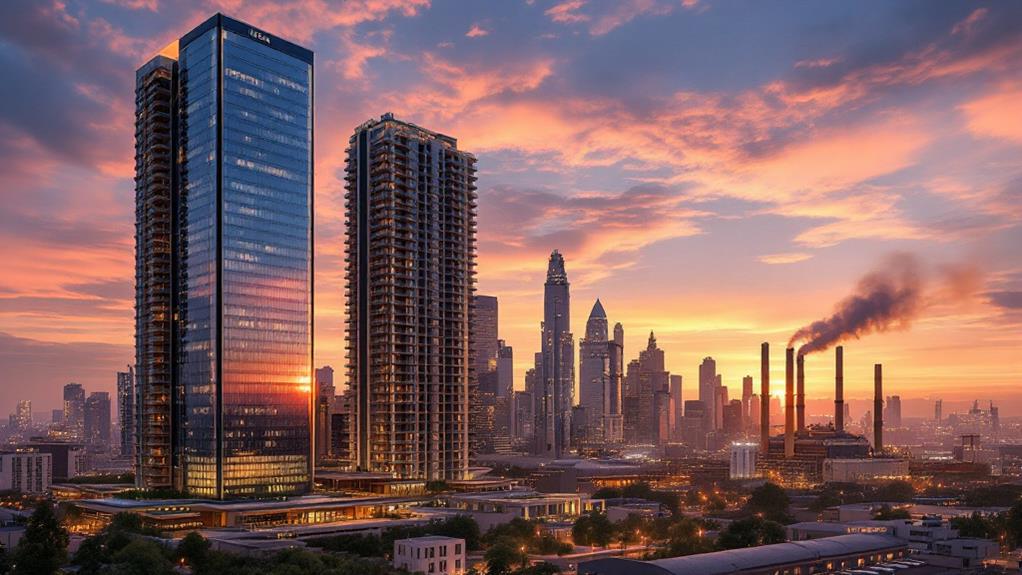
When comparing the world's largest buildings by function, each serves its unique purpose. Commercial giants like UPS Worldport focus on efficiency, handling vast logistics operations. Residential skyscrapers such as One57 in NYC provide luxurious vertical living, catering to urban lifestyles. Industrial behemoths like the General Motors Spring Hill Manufacturing Plant exemplify robust construction for large-scale production. Each type not only defines its role but also influences urban landscapes through architectural innovation, economic impact, and community building. Understanding these structures offers insights into how they shape modern infrastructure and adapt to evolving global trends. There's more to uncover beneath the surface.
Defining Building Types
In relation to defining building types, understanding their primary functions is essential. As you investigate the world of architecture, you'll notice buildings are generally categorized into commercial, residential, and industrial types. Each serves unique roles within urban environments. Commercial buildings, like offices and retail spaces, are designed for business operations, focusing on efficiency and customer interaction. These spaces are crucial in supporting economic activities and enhancing the urban landscape.
When it comes to residential buildings, the priority shifts to providing comfort and fostering community living. Regardless of whether it's a single-family home or an apartment complex, these buildings offer spaces where people live and build their lives. The regulations for residential buildings are typically straightforward, ensuring they're safe and comfortable for inhabitants.
On the industrial side, buildings are constructed to house manufacturing, processing, and distribution activities. Industrial construction demands robust materials and large open spaces to accommodate heavy machinery and intricate processes. These structures must adhere to stricter safety and environmental standards compared to their commercial and residential counterparts. Understanding these differences helps you appreciate how each building type contributes to our urban infrastructure, fulfilling specific needs and functions.
Historical Evolution
The historical evolution of large buildings is a fascinating expedition that reflects advancements in technology and shifts in architectural priorities. You can trace this passage back to the Great Pyramid of Giza, constructed around 2560 BCE, which reigned as the tallest structure for over 3,800 years. This monumental achievement laid the groundwork for future architects and builders. However, the construction landscape began to change dramatically in the 14th century when the Lincoln Cathedral claimed the title of the tallest building, marking a significant milestone in architectural evolution.
Fast forward to the 19th century, the introduction of the safe passenger elevator in 1857 and advancements in steel production during the 1860s transformed building construction. These advancements paved the way for skyscrapers, such as the Home Insurance Building in Chicago, completed in 1885. This building is often hailed as the initial modern skyscraper due to its groundbreaking steel frame.
The 20th century saw the construction of the Empire State Building in 1931, which held the tallest building title until the World Trade Center emerged in 1975. Today, the Burj Khalifa, completed in 2010, stands as the tallest building, showcasing modern engineering marvels.
Commercial Building Giants
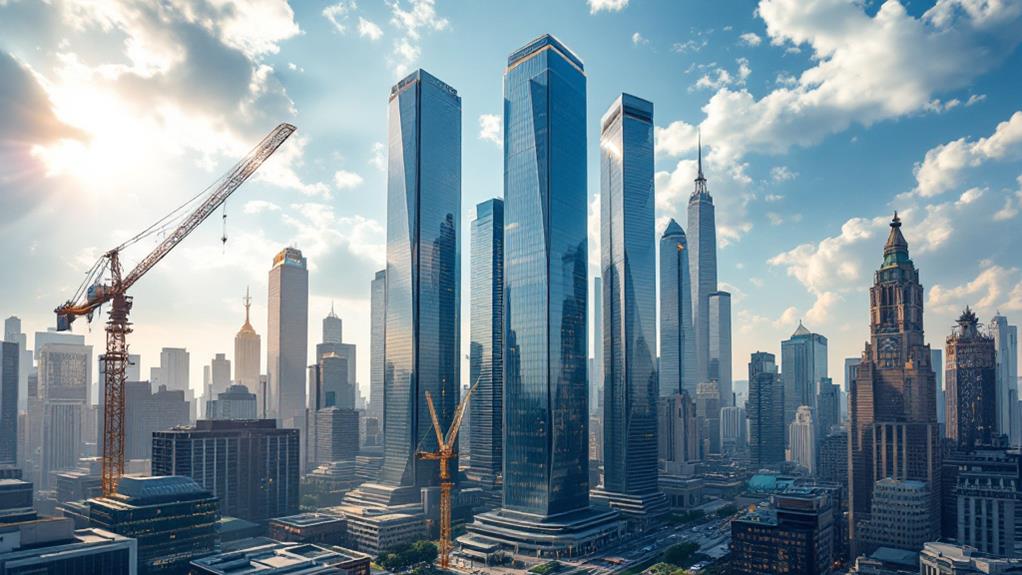
Commercial buildings aren't just about size; they're about impact and innovation. When you investigate the vast expanse of the Daikin Texas Technology Park in Waller, Texas, it's clear this construction project isn't merely large—it's a $417 million demonstration of commercial ambition within the industrial sector. Likewise, the Tesla Gigafactory Texas in Austin showcases the sheer scale of modern real estate, with its 4.2 million square feet dedicated to transforming automotive manufacturing. Plans for a $717 million expansion only underscore its crucial role in the commercial landscape.
In Louisville, Kentucky, the UPS Worldport spans 4.5 million square feet, serving as a critical global air hub. It processes over 416,000 packages hourly, a feat that demonstrates the fundamental nature of logistics within commercial architecture. Meanwhile, One World Trade Center in New York City stands tall with 3.5 million square feet, embodying resilience and cutting-edge design amidst the urban real estate scene.
Don't overlook the General Motors Fort Wayne Assembly Plant in Roanoke, Indiana, at 4.2 million square feet. This facility highlights the trend of expanding commercial manufacturing spaces, echoing the changing demands of the automotive industry. These giants represent the forefront of commercial construction projects.
Residential Skyscrapers
As you shift your gaze from the towering giants of the commercial world, residential skyscrapers rise to capture your attention. These tall buildings redefine urban habitat by offering creative solutions to accommodate growing populations. In cities like Hong Kong and New York, the demand for vertical living has skyrocketed, leading to a surge in residential skyscrapers. These structures aren't just about height; they encapsulate a lifestyle with amenities like swimming pools, fitness centers, and communal spaces, enhancing your living experience.
Imagine living in One57 in New York City, soaring 1,005 feet above the lively streets, or the Marina 101 in Dubai, reaching an impressive 1,400 feet. These residential skyscrapers are iconic examples of how tall buildings can transform urban landscapes. They efficiently use limited land, providing numerous housing units within a smaller footprint compared to sprawling low-rise developments.
Embracing vertical living doesn't just solve space issues; it creates dynamic communities high above the city. As urbanization continues, these towering residences represent a crucial shift in how we think about housing. They're more than just buildings; they're integral components of the modern urban habitat.
Industrial Megastructures
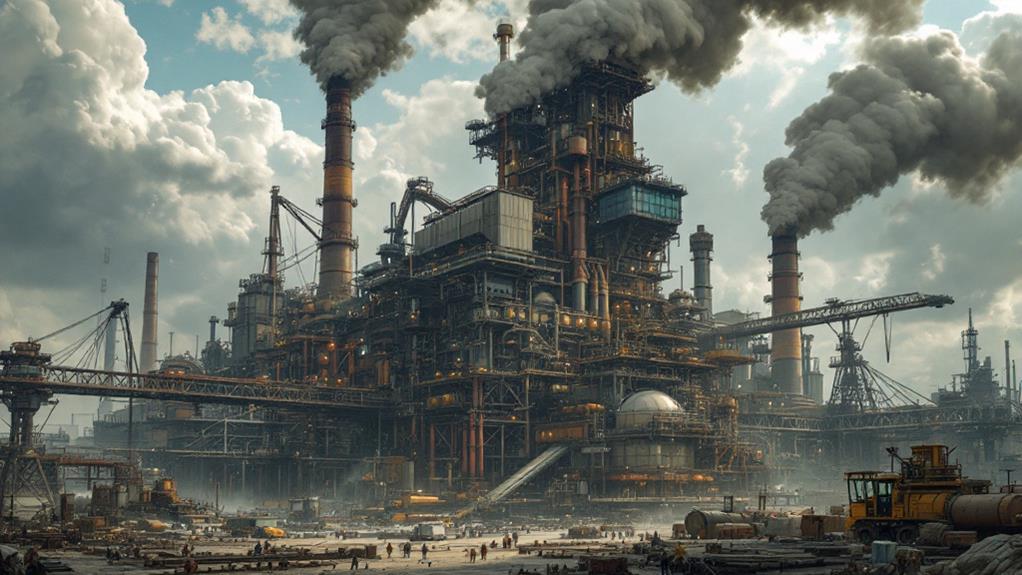
Amidst the sprawling landscapes of modern industry, industrial megastructures rise as symbols of innovation and productivity. These colossal constructions, like the Boeing Everett Factory in Washington, cover an astounding 4.44 million square feet, tailored for large-scale manufacturing processes. You'll find that such industrial megastructures are vital in the contemporary manufacturing landscape, reflecting the shift towards advanced production techniques.
Take the Tesla Gigafactory Texas in Austin. It spans 4.2 million square feet and is central to electric vehicle production, showcasing how industrial construction has evolved to meet the needs of cutting-edge technologies. In the same way, the General Motors Spring Hill Manufacturing Plant in Tennessee, with its 5.2 million square feet, signifies a massive $2 billion investment in retooling for modern demands. These facilities often prioritize function, featuring high ceilings and expansive floor plans to house heavy machinery and extensive production lines.
The global industrial construction market's anticipated growth underscores the increasing demand for such facilities. As you investigate this sector, you'll notice that these megastructures are not just about size but are pivotal enablers of economic activity, adapting to global trends and technological advancements.
Architectural Innovations
Integrating architectural advancements into large buildings involves leveraging cutting-edge materials and techniques to achieve remarkable feats. You'll find that high-strength concrete and advanced steel frames are fundamental in constructing the tallest buildings, like the iconic Burj Khalifa. Reaching an astonishing height of 828 meters, it stays stable thanks to its groundbreaking buttressed core design. This approach not only meets but exceeds building codes, ensuring structural integrity amidst challenging wind forces.
Incorporating smart building technologies is another trend you can't ignore. Energy-efficient systems and automated controls are now standard in large commercial structures, optimizing sustainability and resource use. These advancements are vital as we push for greener building practices. When you look at projects like the Tesla Gigafactory Texas, modular construction techniques stand out. They enable rapid assembly and scalability, which are necessary for meeting modern demands efficiently.
In designing skyscrapers, advancements in wind resistance and seismic safety are significant. Skyscrapers like the Shanghai Tower use aerodynamic forms to handle lateral forces effectively. These breakthroughs are not just architectural achievements but fundamental adaptations to meet stringent building codes, ensuring safety and longevity in the world's tallest buildings.
Global Construction Trends
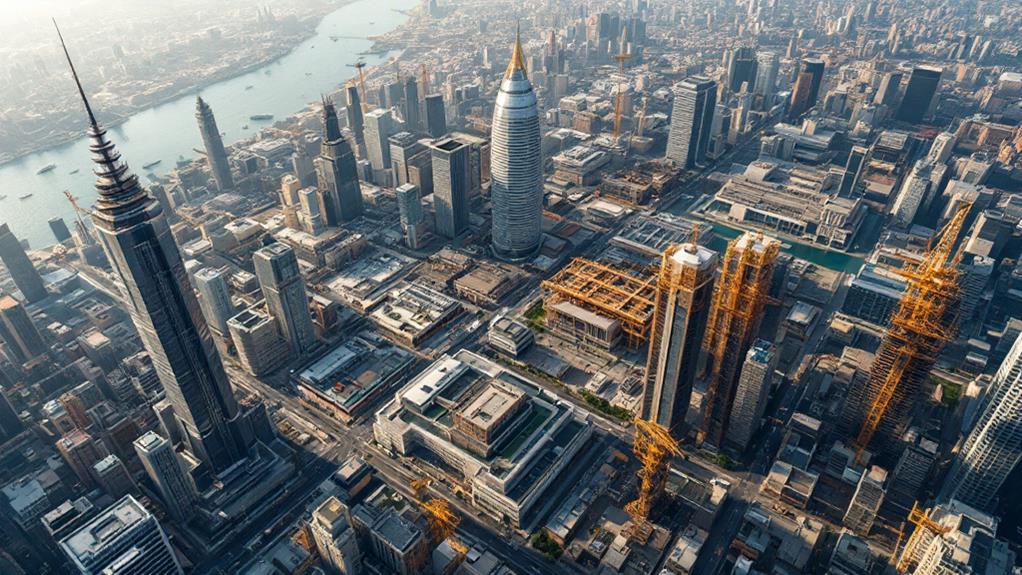
Architectural innovations set the stage for understanding the broader patterns shaping the global construction industry. With a projected value increase from $6.4 trillion in 2020 to $14.4 trillion by 2030, global construction trends reflect significant growth and diversification. Urbanization continues to drive demand for tall buildings, especially in Asia and the Middle East. These regions benefit from lower construction costs, paving the way for swift development and the creation of impressive skylines.
As you observe these trends, consider how construction involves creating facilities that meet modern needs. The rise of e-commerce has particularly increased the demand for logistics and distribution centers. This shift highlights the critical role such facilities play in the contemporary economy. Meanwhile, sustainable building practices are gaining prominence, addressing environmental concerns by prioritizing green materials and energy-efficient designs.
Key trends include:
- Urbanization and tall buildings: Rapid city growth fuels the demand for high-rise structures.
- E-commerce impact: Surge in logistics centers underscores their economic importance.
- Sustainability focus: Growing emphasis on eco-friendly materials and designs.
These elements illustrate how global construction trends are reshaping the landscape, preparing for a future that values both efficiency and sustainability.
Technological Advances
Innovations in construction technology are transforming the way we build, making structures not only larger but also more sustainable and efficient. With technological advances in materials like high-strength concrete and steel, you can now see the rise of taller buildings that are structurally sound and sustainable. These materials have changed the commercial, residential, and industrial sectors by enabling the construction of massive structures that were previously unimaginable.
You'll find modular construction and prefabrication particularly fascinating. These methods have greatly cut down construction time and costs, allowing for the swift creation of large industrial and commercial facilities. Imagine erecting a skyscraper in record time without compromising quality—these innovations make it possible.
Smart building technologies are another game-changer. By integrating energy-efficient systems and automation, commercial buildings can notably reduce operational costs while enhancing sustainability. It's all about using technology to make these giants of architecture as eco-friendly as possible.
Furthermore, the application of advanced geospatial imagery and computer vision technology offers precise building dimension assessments, aiding urban development. Seismic safety and wind resistance technologies are crucial, especially for tall buildings in disaster-prone areas, ensuring their resilience and longevity. This evolution in building technology truly redefines the skyline.
Economic and Cultural Impacts
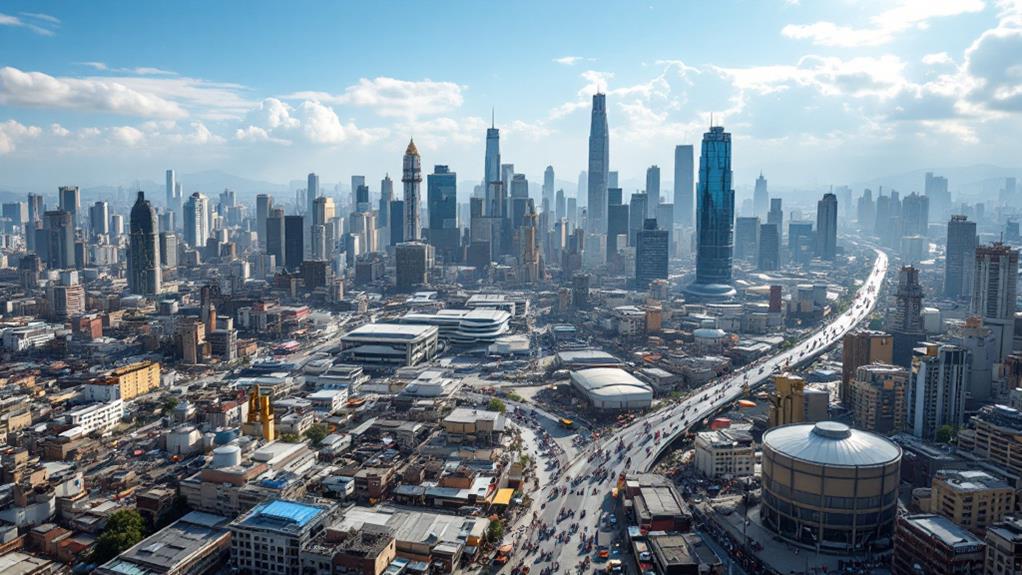
Transforming urban landscapes, large buildings have profound economic and cultural impacts that ripple across communities. You can see this in how commercial giants like the UPS Worldport revolutionize global trade by processing over 416,000 packages hourly. This efficiency in logistics and supply chain directly contributes to economic growth, enabling businesses to thrive. On the industrial front, the Tesla Gigafactory Texas not only creates thousands of jobs but also pioneers sustainable manufacturing, reflecting the industry's shift towards electric vehicles.
Large residential complexes play an essential role, too. They attract businesses and services, increasing local economies as they cater to the growing population. These buildings also influence urban planning, leading to improved infrastructure and public services.
Architectural landmarks, such as the Burj Khalifa, are more than just the tallest buildings. They symbolize cultural aspirations and national pride, attracting tourists and greatly enhancing local economies through visitor spending.
Consider the broad impacts these structures have:
- Facilitate global trade and logistics efficiency
- Drive tourism and cultural pride
- Improve local economies through housing and job creation
Each of these factors underscores the critical role large buildings play in shaping economic and cultural landscapes.
Future of Building Design
As we look to the future, building design is set to undergo transformative changes centered on sustainability and efficiency. You'll see a shift towards energy-efficient materials and technologies that reduce carbon footprints, promoting environmental responsibility. Smart building technologies are now standard, integrating IoT devices to manage and optimize energy use, which improves operational efficiency. With these advancements, buildings are not just structures but active participants in resource conservation.
Modular construction is another trend gaining traction, offering quick assembly and minimal waste. These prefabricated techniques aren't just cost-effective; they maintain high-quality standards, making them an attractive option for developers. You'll notice that modular designs aren't limited to residential projects—they're making their way into commercial and industrial spaces too.
Additionally, the use of advanced materials like high-strength concrete and steel allows for designing taller, more resilient structures that can withstand extreme weather and seismic events. As urbanization continues, there's a growing demand for mixed-use developments. These spaces combine residential, commercial, and recreational areas, fostering community engagement and reducing reliance on transportation. In the future, expect buildings to not only meet your needs but also contribute to a sustainable world.



